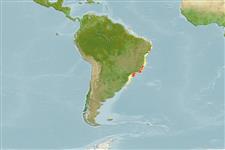>
Ovalentaria/misc (Various families in series Ovalentaria) >
Opistognathidae (Jawfishes)
Etymology: Opistognathus: Greek, opisthe = behind + Greek, gnathos = jaw (Ref. 45335); to the very elongate upper jaw of the type species of the genus, Opistognathus nigromarginatus (Ref. 128653); brasiliensis: Named after Brazil, along whose coast this species appears to be endemic (Ref. 26893).
Environment: milieu / climate zone / depth range / distribution range
Écologie
marin démersal; profondeur 15 - 69 m (Ref. 129348). Subtropical
Southwest Atlantic: Brazil.
Taille / Poids / Âge
Maturity: Lm ? range ? - ? cm
Max length : 12.9 cm SL mâle / non sexé; (Ref. 26893)
Description synthétique
Clés d'identification | Morphologie | Morphométrie
Épines dorsales (Total) : 11; Rayons mous dorsaux (Total) : 16; Épines anales: 3; Rayons mous anaux: 15 - 16; Vertèbres: 28. Anterior nostril a short tube with simple cirrus on posterior rim; posterior end of maxilla of adult males produced as a thin flexible lamina that usually extends beyond posterior margin of opercle; spinous dorsal fin with black spot encircled by a very narrow white ring; dorsal fin with 5 or 6 dusky bands that extend onto dorsum; adult males with inner lining of maxilla and adjacent membranes with 2 dark stripes, one stripe in females; pectoral fin uniformly pigmented, no black speckles proximally; buccal pigmentation consisting of a dark area widely surrounding esophageal opening except for a pale area posteriorly that continues between upper pharyngeal tooth patches; caudal vertebrae 8 (Ref. 26893).
Founf on bottoms with gravel and sand or on silt and sand bottoms, near coral reefs and rocky areas (Ref. 129348). Mouthbrooders (Ref. 240).
Life cycle and mating behavior
Maturities | Reproduction | Spawnings | Egg(s) | Fecundities | Larves
Employ mouthbrooding to care for their young (Ref. 240).
Smith-Vaniz, W.F., 1997. Five new species of jawfishes (Opistognathus: Opistognathidae) from the western Atlantic ocean. Bull. Mar. Sci. 60(3):1074-1128. (Ref. 26893)
Statut dans la liste rouge de l'IUCN (Ref. 130435)
Menace pour l'homme
Harmless
Utilisations par l'homme
Outils
Articles particuliers
Télécharger en XML
Sources Internet
Estimates based on models
Preferred temperature (Ref.
123201): 20.2 - 23.1, mean 21.7 °C (based on 5 cells).
Phylogenetic diversity index (Ref.
82804): PD
50 = 0.5000 [Uniqueness, from 0.5 = low to 2.0 = high].
Bayesian length-weight: a=0.00389 (0.00180 - 0.00842), b=3.12 (2.94 - 3.30), in cm total length, based on all LWR estimates for this body shape (Ref.
93245).
Niveau trophique (Ref.
69278): 3.5 ±0.6 se; based on size and trophs of closest relatives
Fishing Vulnerability (Ref.
59153): Low vulnerability (10 of 100).
